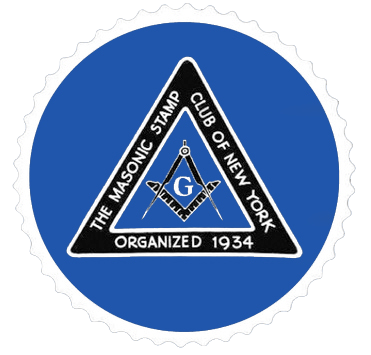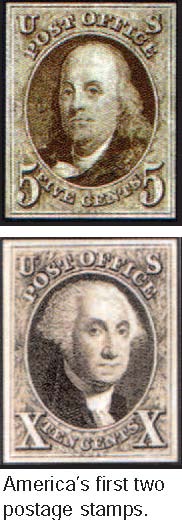On January 13, 1934, a group of Freemasons gathered in the Grand Lodge Library and Museum on 23rd Street in New York City. However, it was not for Masonry alone that they had assembled, all had another interest in common they were philatelic enthusiasts.
Dr. Charles H. Johnson, Past Grand Master of New York, current Grand Secretary, and member of The Collectors Club, was in the Chair. Over 40 brethren were in attendance.
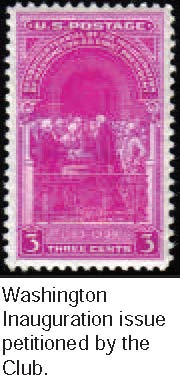
It wasn't long before the original group was joined by many more Brethren, and the Masonic Stamp Club of New York was well on its way. The Club meetings were for the purpose of friendly discussions on the subject of postage stamp collecting and postal history. Of particular interest to all was the fact that many eminent Freemasons were (and continue to be) depicted on postage stamps. It certainly did not go without notice that the first two postage stamps issued by the United States showed Benjamin Franklin and George Washington, both highly distinguished Freemasons. Furthermore, numerous other stamps could be considered Masonic-related, as they showed works created by a Freemason, or celebrated events in which Freemasons played a major role.
An informal communication to members on philatelic subjects and Club activities found its way to lodges in the United States, Canada, and other countries, resulting in membership requests beyond New York City. One request was from President Franklin Delano Roosevelt, a noted Freemason, ardent stamp collector, and even a stamp designer.
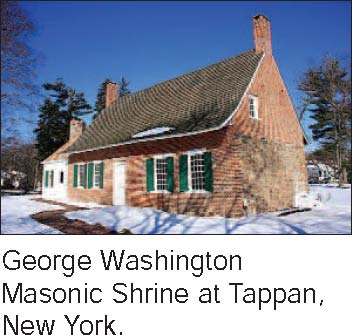 Late in 1938, the Club petitioned President Roosevelt to issue a commemorative stamp honoring the 150th anniversary of the inauguration of George Washington as the first President of the United States. The following year the stamp (shown above) was issued. When it became known that the stamp would be released, the Club prepared a special first day cover envelope as a Masonic souvenir. On the day of issue, April 30, 1939, the covers were sold to Club members all over the world for the sum of ten cents each. The proceeds of this initiative were contributed for the support the George Washington Masonic Shrine (old dwelling seen on the right) at Tappan, New York. The quaint little house was built in 1700 and it was often visited and occupied during the Revolutionary War by our distin
guished Brother, George Washington. The Grand Lodge of New York maintains the shrine.
Late in 1938, the Club petitioned President Roosevelt to issue a commemorative stamp honoring the 150th anniversary of the inauguration of George Washington as the first President of the United States. The following year the stamp (shown above) was issued. When it became known that the stamp would be released, the Club prepared a special first day cover envelope as a Masonic souvenir. On the day of issue, April 30, 1939, the covers were sold to Club members all over the world for the sum of ten cents each. The proceeds of this initiative were contributed for the support the George Washington Masonic Shrine (old dwelling seen on the right) at Tappan, New York. The quaint little house was built in 1700 and it was often visited and occupied during the Revolutionary War by our distin
guished Brother, George Washington. The Grand Lodge of New York maintains the shrine.
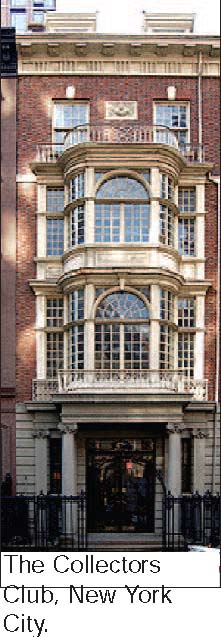
In time, the Club outgrew various meeting rooms at the Grand Lodge of New York building on 23rd Street. As a result, in 1944 it asked the Collectors Club on 35th Street (seen on the left) for accommodations. This request was granted and meetings were held there through the courtesy of the Collectors Club, and continued to be held at this location up to the present time.
During the early 1940s, many famous men depicted on postage stamps were determined by Club members to have been Freemasons. It was this condition that led to the term "Masonic Philately." Indeed, finding new stamps of this nature was (and still is) very gratifying. We need to keep in mind that it would be some 18 years (1958) before William Denslow would complete his epic tome 10,000 Famous Freemasons, so determining Masonic memberships was a bit of a chore for our early stamp collecting brethren.
In March 1944 publication of The Masonic Philatelist, a monthly journal, commenced. This journal is now a quarterly periodical which is highly respected in the field of philately and enjoyed by Club members all over the world.
The first Masonic topical stamp collection to win a major prize was the Masonic Philately Exhibit provided at the May 1947 Centenary International Philatelic Exhibit (CIPEX) held in New York City.
Interest in the Masonic area of philately has grown to the extent that Masonic Philately is now a fully recognized stamp specialty by the American Topical Association, American Philatelic Society, and the British Thematic Association. Masonic-related collections are exhibited at many major stamp shows. The Masonic Stamp Club of New York continues its long-standing practice of participating in the major American Stamp Dealers Association events in New York City.
Over the years the Club has sponsored many first day covers, as well as other cachets honoring Freemasons and Masonic events. Some of the most popular cachet issues were: George Washington, Fiorello La Guardia, Harry S Truman, and the St. John's Lodge No. 1 (New York City) Bible used at George Washington's inauguration. Many of these attractive mementos are given away and serve to develop a positive interest in Freemasonry. All proceeds from the donations received are directed to charitable organizations.
The Club has encouraged the formation of other Masonic stamp clubs, and a source of Club pride was the establishment of George Washington Chapter No. 1 (Washington D.C.), now the George Washington Masonic Stamp Club.
Throughout the last 80 years, numerous distinguished brethren have contributed to the success of the Club with both the provision of researcher material and administration. The Club presidents were as follows:
Bro. Arthur W. Deas
Bro. Henry W. Holocombe
Bro. Dr. George Camnitzer
Bro. Samuel Brooks
Bro. Russell Roans
Bro. Dr. Irving M. Yarry
Bro. Shelton W. Osterlund
Bro. Joseph Nathan Kane
Bro. Dr. Allan Boudreau
Bro. George Wettach
Bro. Nicolas Batalias
Bro. Christopher L. Murphy
Of course, as with all organizations of this nature, the primary publishing work is done by the Club editors and publishers. The following brethren have served in these capacities.
Bro. Hermain Kerstein
Bro. Leo Passon
Bro. Norman Sehlmeyer
Bro. Dudley Hilborn
Bro. Roy T. Ketcham
Bro. Dr. Erwin M. Yarry Bro.
Dr. Allan Boudreau
All of these brethren, save Bro. Boudreau* and Murphy have passed on the Grand Lodge Above. It is with fondness and admiration that we remember them.
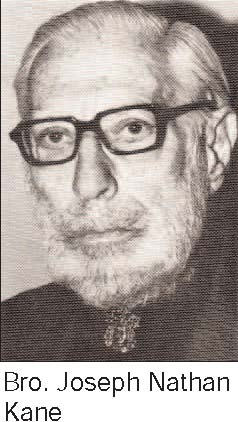
One of our most notable members, and past president, was Bro. Joseph Nathan Kane, the author of Famous First Facts (H. W. Wilson Company, 1981) and several other highly regarded reference books. In addition, Bro. Kane was the authority and writer for the television program Break the Bank, which ran for 18 years. Furthermore, he supplied the questions for the televisions show, The $64,000 Question. He even had his own show; Famous Firsts. provided by Mutual Broadcasting.
The Masonic Stamp Club of New York,,and other Masonic stamp clubs that were essentially brought about by it, have identified several thousands Masonic-related stamps. The stories of such stamps issued by the United States and Canada were compiled by Bro. Chris Murphy in his book Postage Stamps and Freemasonry: Guide & Compendium, United States & Canada. (Carlton Press Inc., New York, N.Y., 1988). Bro. Murphy was inspired to write the book after he was given a large collection of back issues of The Masonic Philatelist. He then acquired copies of other Club journal back issues (most notably The Philatelic Freemason: Journal of the Masonic Study Unit, edited and published by Robert A Domingue, Andover, Massachusetts). The combined knowledge in these publications was indeed astounding and highly worthy of a proper book.
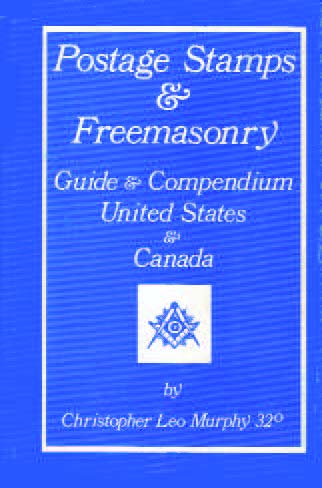 Inspired by the Masonic Stamp Club of New York, Murphy's book has become part of the Club's legacy. The book was obtained by libraries of every nature (Masonic, private, public) right across North America.
Inspired by the Masonic Stamp Club of New York, Murphy's book has become part of the Club's legacy. The book was obtained by libraries of every nature (Masonic, private, public) right across North America.
The Masonic Stamp Club of New York was highly supportive of Bro. Murphy's endeavor and the book served to reinforce Masonic Philately as a valid part of topical stamp collecting.
With the support, encouragement, and confidence of Bro. Boudreau, in 1990 Bro. Murphy authored a work, Masonic Philately: The United States of America & Canada, for the Masonic Service Association, Silver Spring, Maryland.
Over the next five years, with the cooperation of the Masonic Stamp Club of New York, Murphy published his serialized Masonic Specialist which expanded upon the same subject (inclusion of more "related" stamps).
In 2001, Bro. Murphy worked with Bro. Boudreau to produce an official handbook of he Masonic Stamp Club of New York covering US and Canadian stamps that depict a Freemason. The work was published by the America. American Topical Association (ATA) as Handbook No. 141).The following year, the two produced another official handbook, Masonic Philately: Government Issue Masonic Stamps. This work was also published by the ATA (Handbook No. 145).
The extent, quality and source of inspiration of the material published by the Club in its journal, The Masonic Philatelist, over the last 80 years is in itself a permanent tribute to the many brethren who formed the Club, and those who followed to both support and move forward with research. It is also a tribute to the Masonic Order and all the wonderful Freemasons in every walk of life who are depicted on, or connected with, postage stamps.
Update: Bro. Boudreau passed to the Grand Lodge Above since this article was written.
